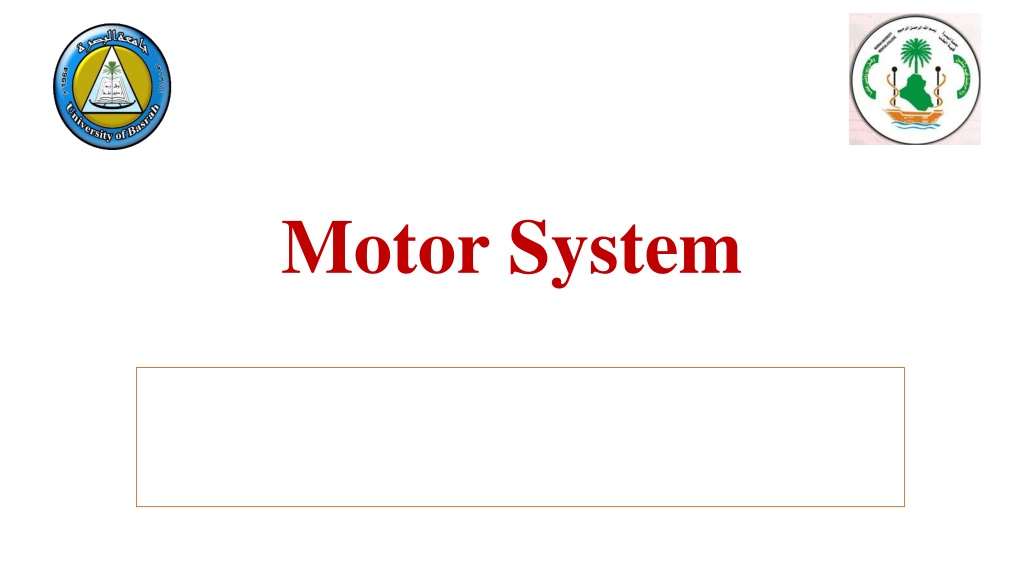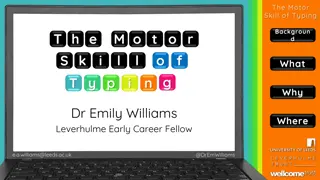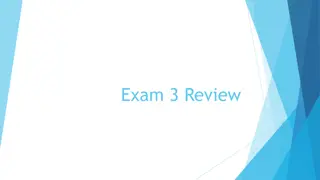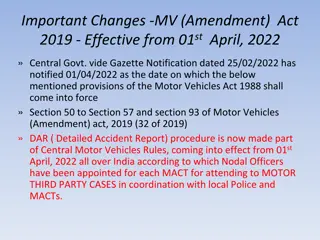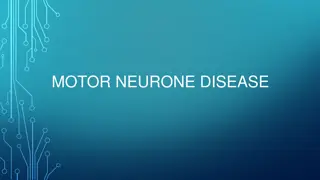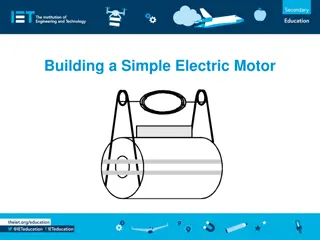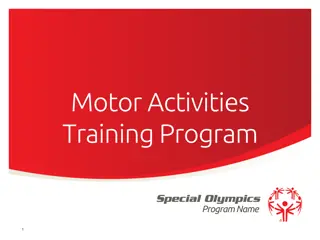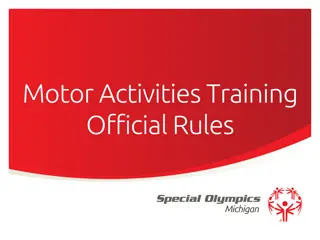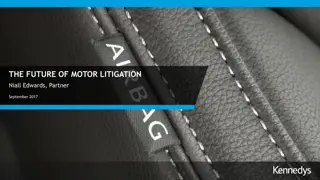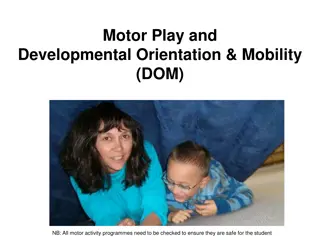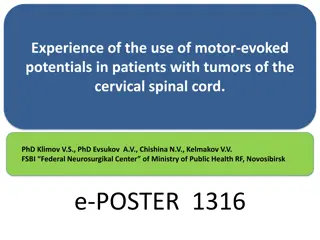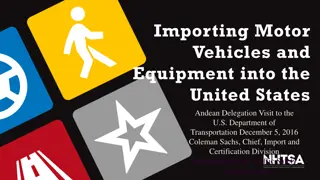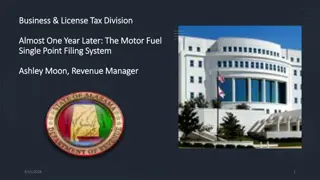Motor System
The motor cortex, an integral part of the cerebral cortex, plays a crucial role in planning, controlling, and executing voluntary movements. Discover the primary motor cortex, premotor area, and supplementary motor area, each with unique topographical representations of muscle groups. Explore how more than half of the primary motor cortex is dedicated to hand and speech muscle control, emphasizing specific movements over individual muscles.
Download Presentation

Please find below an Image/Link to download the presentation.
The content on the website is provided AS IS for your information and personal use only. It may not be sold, licensed, or shared on other websites without obtaining consent from the author.If you encounter any issues during the download, it is possible that the publisher has removed the file from their server.
You are allowed to download the files provided on this website for personal or commercial use, subject to the condition that they are used lawfully. All files are the property of their respective owners.
The content on the website is provided AS IS for your information and personal use only. It may not be sold, licensed, or shared on other websites without obtaining consent from the author.
E N D
Presentation Transcript
Lecture 3 motor cortex Objectives 1. What is motor cortex 2. Main Motor cortex areas 3. Some specialized areas of motor cortex. 2
The motor cortex is the region of the cerebral cortex involved in the planning, control, and execution of voluntary movements. 3 University of Basrah-College of Medicine-Physiology Department
Motor Cortex Anterior to the central cortical sulcus, occupying approximately the posterior one third of the frontal lobes, It divided in to 3 Areas: 1)primary motor cortex 2)premotor area 3)supplementary motor area 4 University of Basrah-College of Medicine-Physiology Department
5 University of Basrah-College of Medicine-Physiology Department
Each has its own topographical representation of muscle groups and specific motor functions of the body. 6 University of Basrah-College of Medicine-Physiology Department
PRIMARY MOTOR CORTEX lies in the first convolution of the frontal lobes anterior to the central sulcus topographical representations of the different muscle areas of the body in the primary motor cortex 7 University of Basrah-College of Medicine-Physiology Department
8 University of Basrah-College of Medicine-Physiology Department
9 University of Basrah-College of Medicine-Physiology Department
10 University of Basrah-College of Medicine-Physiology Department
Note that more than one half of the entire primary motor cortex is concerned with controlling the muscles of the hands and the muscles of speech. excitation of a single motor cortex neuron usually excites a specific movement rather than one specific muscle. 11 University of Basrah-College of Medicine-Physiology Department
PREMOTOR AREA lies 1 to 3 centimeters anterior to the primary motor cortex. 12 University of Basrah-College of Medicine-Physiology Department
13 University of Basrah-College of Medicine-Physiology Department
The topographical organization of the premotor cortex is roughly the same as that of the primary motor cortex, with the mouth and face areas located most laterally. 14 University of Basrah-College of Medicine-Physiology Department
Nerve signals generated in the premotor area cause much more complex patterns of movement than the that generated in the primary motor cortex. For instance, the pattern may be to position the shoulders and arms so that the hands are properly oriented to perform specific tasks. 15 University of Basrah-College of Medicine-Physiology Department
SUPPLEMENTARY MOTOR AREA It extends a few centimeters onto the superior frontal cortex. The supplementary motor area has yet another topographical organization for the control of motor function. 16 University of Basrah-College of Medicine-Physiology Department
17 University of Basrah-College of Medicine-Physiology Department
.this area functions in concert with the premotor area to provide body-wide attitudinal movements, fixation movements of the different segments of the body, positional movements of the head and eyes. 18 University of Basrah-College of Medicine-Physiology Department
SOME SPECIALIZED AREAS OF MOTOR CONTROL FOUND IN THE HUMAN MOTOR CORTEX control specific motor functions. 19 University of Basrah-College of Medicine-Physiology Department
Brocas Area (Motor Speech Area) It s the site for expression of words by exciting simultaneously the laryngeal muscle, respiratory muscles and muscles of the mouth. Damage to this area motor aphasia Damage to this area does not prevent a person from vocalizing, but it does make it impossible for the person to speak whole words. 20 University of Basrah-College of Medicine-Physiology Department
Voluntary Eye Movement Field In the premotor area immediately above Broca s area a locus for controlling voluntary eye movements. Damage to this area prevents a person from voluntarily moving the eyes toward different objects. 21 University of Basrah-College of Medicine-Physiology Department
Head rotation area Its closely associated with eye movement field and related to directing the head toward different objects. 22 University of Basrah-College of Medicine-Physiology Department
Area for hand skills In the premotor area . Is a region that is important for hand skills. lesions cause destruction in this area, hand movements become uncoordinated and non purposeful, a condition called motor apraxia 23 University of Basrah-College of Medicine-Physiology Department
Recap Motor cortex: Anterior to the central cortical sulcus, occupying approximately the posterior one third of the frontal lobes. PRIMARY MOTOR CORTEX, PREMOTOR AREA SUPPLEMENTARY MOTOR AREA Broca s Area (Motor Speech Area): expression of words. Voluntary Eye Movement Field: controlling voluntary eye movements. Head rotation area: eye movement field and related to directing the head. Area for hand skills( control hand movement). 24
Lecture 4 transmission of motor signals Objectives Direct: Pyramidal pathway. Pyramidal pathway fibers. The pathway from motor cortex down to muscle. Indirect : extrapyramidal tract : Red nucleus 25
Motor signals are transmitted Directly from the cortex to the spinal cord through the corticospinal tract (Pyramidal) Indirectly through multiple accessory pathways that involve the basal ganglia, cerebellum, and various nuclei of the brain stem ( Extrapyramidal) 26 University of Basrah-College of Medicine-Physiology Department
Corticospinal (Pyramidal) Tract The most important output pathway from the motor cortex Its originates about: 30 percent from the primary motor cortex 30 percent from the premotor and supplementary motor areas and 40 percent from the somatosensory areas posterior to the central sulcus. 27 University of Basrah-College of Medicine-Physiology Department
Pyramidal tract fibers Large fibers (3%) 16 m in diameter originating from Betz cells Other fibers (97%) 4 m in diameter Faster conduction (70m/sec) Slower conduction Ends directly in the motor neuron Synapse with interneurons which in turn synapse with or motor neuron. 28 University of Basrah-College of Medicine-Physiology Department
29 University of Basrah-College of Medicine-Physiology Department
The majority of the pyramidal fibers then cross in the lower medulla to the opposite side and descend into the lateral corticospinal tracts of the cord, finally terminating principally on the interneurons in the intermediate regions of the cord gray matter 30 University of Basrah-College of Medicine-Physiology Department
A few of the fibers do not cross to the opposite side in the medulla but pass ipsilaterally down the cord in the (ventral or anterior corticospinal tracts.) Many, if not most, of these fibers eventually cross to the opposite side of the cord either in the neck or in the upper thoracic region. University of Basrah-College of Medicine-Physiology Department 31
Extrapyramidal System _All descending tracts other than the pyramidal tract called extrapyramidal tracts _Pyramidal and extrapyramidal tracts should function together for smooth activity _Background tone, posture, equilibrium etc., are maintained by extrapyramidal system _Voluntary activity is controlled by pyramidal system 32 University of Basrah-College of Medicine-Physiology Department
Extrapyramidal fibers arise from 1. Cerebral cortex 33 University of Basrah-College of Medicine-Physiology Department
2. Subcortical structures Reticular formation of brain stem vestibular nuclei Basal Ganglia Red Nucleus And others like tectal nucleus and olivary nucleus 34 University of Basrah-College of Medicine-Physiology Department
Red Nucleus 35 University of Basrah-College of Medicine-Physiology Department
THE RED NUCLEUS Structure in the rostral midbrain involved in motor coordination SERVES AS AN ALTERNATIVE PATHWAY FOR TRANSMITTING CORTICAL SIGNALS TO THE SPINAL CORD 36 University of Basrah-College of Medicine-Physiology Department
Corticorubrospinal Fibers from primary motor cortex synapse with large neurons in magnocellular portion of red nuceus corticorubral tract Fibers from red nucleus to spinal cord rubrospinal tract Which crosses to the opposite side in the lower brain stem and follows a course immediately adjacent and anterior to the corticospinal tract . 37 University of Basrah-College of Medicine-Physiology Department
38 University of Basrah-College of Medicine-Physiology Department
Functions of Corticorubrospinal tract It has a representation of all the muscles of the body, as is true of the motor cortex. The representation of the different muscles is far less developed than in the motor cortex (it is relatively small in human beings) The corticorubrospinal pathway serves as an accessory route for transmission of signals from the motor cortex to the spinal cord. 39 University of Basrah-College of Medicine-Physiology Department
When the corticospinal fibers are destroyed but the corticorubrospinal pathway is intact, discrete movements can still occur, except that the movements for fine control of the fingers and hands are considerably impaired. 40 University of Basrah-College of Medicine-Physiology Department
Recap 1. Pathways of motor transmission : direct Pyramidal and indirect Extrapyramidal . 2.corticospinal tract :The majority will cross in the lower medulla to the opposite side and descend into the lateral corticospinal tracts of the cord, terminating on the interneurons in the intermediate regions of the cord gray matter. few of the fibers do not cross to the opposite side in the medulla but pass ipsilaterally down the cord in the (ventral or anterior corticospinal tracts.) 3. Red nucleus: Structure in the rostral midbrain involved in motor coordination, transmission of discrete signals from the motor cortex to the spinal cord. 41
